Question #a5065
1 Answer
Explanation:
The idea here is that you need to use the Periodic Table of elements to find the mass number of the most common isotope of phosphorus,
Once you know the mass number, you can use the element's atomic number to find the number of neutrons it contains in its nucleus.
So, grab a Periodic Table and look for phosphorus. You'll find it located in period
To find the mass number of the most common isotope of phosphorus, round the element's relative atomic mass, which you'll find written at the bottom of the element's box, to the nearest whole number.
In this case, you have
#30.974 ~~ 31 -># rounded to the nearest whole number
This means that the most common isotope of phosphorus is phosphorus-31, meaning that its mass number is equal to
Now, you know that
#color(red)(ul(color(black)("mass number" = "no. of protons" + "no. of neutrons")))#
or
#color(red)(ul(color(black)(A = Z + "no. of neutrons")))#
The number of protons located in the nucleus is given by the element's atomic number,
In this case, you have
#Z_"P" = 15#
Therefore, the number of neutrons present inside the nucleus of a phosphorus-31 isotope is equal to
#"no. of neutrons" = A - Z#
#"no. of neutrons" = 31 - 15 = 16#
Now all you have to do is to figure out what percentage of
#16 * (100%)/31 = color(darkgreen)(ul(color(black)(51.6%)))#
You can thus say that


